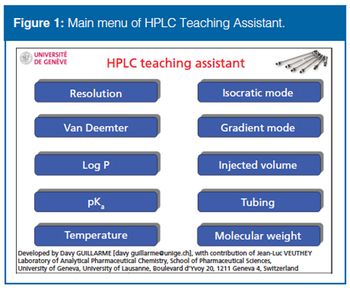
A new free simulator is available for students, educators, and trainers to teach and perform virtual HPLC experiments that are applicable to real HPLC instrumentation and method development.

A new free simulator is available for students, educators, and trainers to teach and perform virtual HPLC experiments that are applicable to real HPLC instrumentation and method development.

There has been a great renewal of interest in supercritical fluid chromatography (SFC) as a performing analytical tool for various types of applications recently. SFC is particularly suitable for pharmaceutical analysis, where it is required to have separation methods offering high throughput, elevated efficiency, and, importantly, sensitivity for the determination of drugs in various matrices, such as drug formulation and biological fluids. However, SFC has also been used for other applications, including food analysis, polymer analysis, and environmental analysis, as reported in a recent review.

The free spreadsheet-based program HPLC Teaching Assistant was developed for effective and innovative learning and teaching of liquid chromatography. This software allows teachers to illustrate the basic principles of high performance liquid chromatography (HPLC) using virtual chromatograms (simulated chromatograms) obtained under various analytical conditions. In the first instalment of this series, we demonstrate the possibilities offered by this spreadsheet to illustrate the concept of chromatographic resolution, including the impact of retention, selectivity, and efficiency; understand the plate height (van Deemter) equation and kinetic performance in HPLC; recognize the importance of analyte lipophilicity (log P) on retention and selectivity in reversed-phase HPLC mode; and manipulate or adapt reversed-phase HPLC retention, taking into account the acido-basic properties (pKa) of compounds and the mobile-phase pH.

Part II of this series describes additional features of the HPLC Teaching Assistant software, including the possibility to simulate the impact of the mobile phase temperature on HPLC separations; understand the chromatographic behavior of a mixture of diverse compounds in both isocratic and gradient elution modes; show the influence of instrumentation (injected volume and tubing geometry) on the kinetic performance and sensitivity in HPLC; and demonstrate the impact of analyte molecular weight on thermodynamic (retention and selectivity) and kinetic (efficiency) performance.

The recent trends in column technology for reversed-phase LC, SEC, ion-exchange chromatography, and HIC for analysis of biopharmaceuticals are critically discussed.

This free software allows teachers to illustrate the basic principles of HPLC, such as chromatographic resolution, the van Deemter equation, and how to manipulate or adapt retention in reversed-phase HPLC.

Jean-Luc Veuthey and Alexandre Grand-Guillaume-Perrenoud reveal the latest developments in supercritical fluid chromatography (SFC) that are bringing the technique back to the limelight.

The recent trends in column technology for reversed-phase LC, SEC, IEX, and HIC for analysis of biopharmaceuticals at the protein level is critically discussed.

Modern Column Technologies for the Analytical Characterization of Biopharmaceuticals in Various Liquid Chromatographic Modes

Hydrophilic interaction liquid chromatography (HILIC) has recently become more important, particularly for the analysis of polar drugs, metabolites and biologically relevant compounds in glycomics, proteomics, metabolomics and clinical analysis. HILIC makes it possible to increase the retention of polar compounds, achieve orthogonal selectivity and increase mass spectrometry (MS) sensitivity, compared with reversed-phase liquid chromatography. This article discusses the advantages and limitations of HILIC in a variety of practical applications in the pharmaceutical industry.

Very short columns filled with 1.9 µm particles were evaluated for the ultra-fast analysis of pharmaceutical formulations. Local anæsthetic, mydriatic and anti-hypertensive agents were chosen as analytes and a method was developed and validated for each of these substances, according to ICH guidelines. Excellent quantitative performance was obtained using an optimized chromatographic system that reduces the importance of extra-column effects and cuts the analysis time to less than 15 s.

Many HPLC analyses could be performed at lower expenditure. This could involve a combination of reducing the analysis time, reducing the resolution between critical peaks, and lowering the consumption of mobile phase. Successfully optimizing the method in such instances - as well as in situations where it is necessary to transfer the method to another laboratory that lacks the same selection of columns - can save the analyst time and money.

Published: March 1st 2021 | Updated:

Published: May 2nd 2013 | Updated:

Published: June 1st 2008 | Updated:

Published: October 1st 2008 | Updated:

Published: October 2nd 2015 | Updated:

Published: March 8th 2016 | Updated: